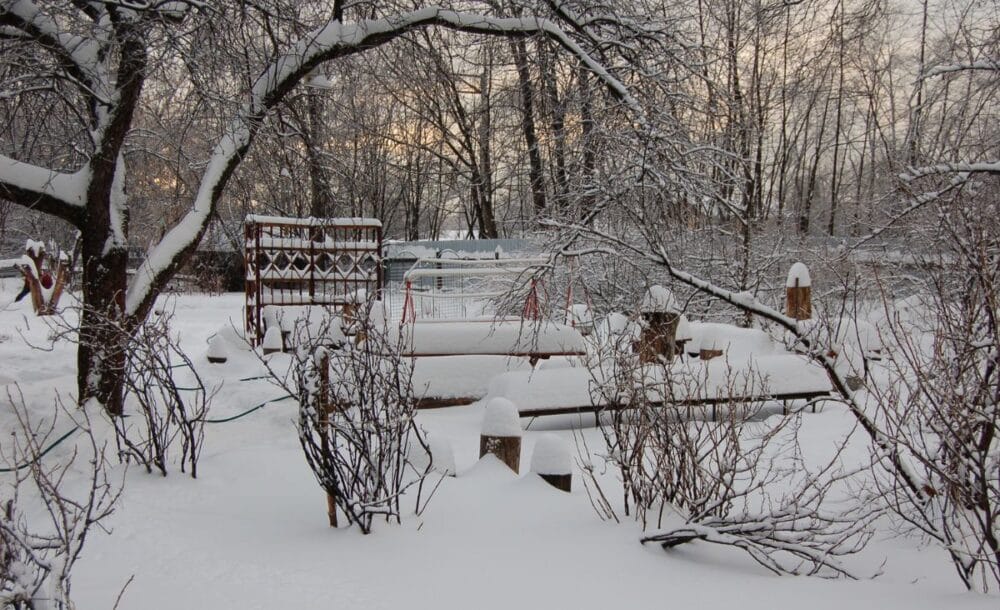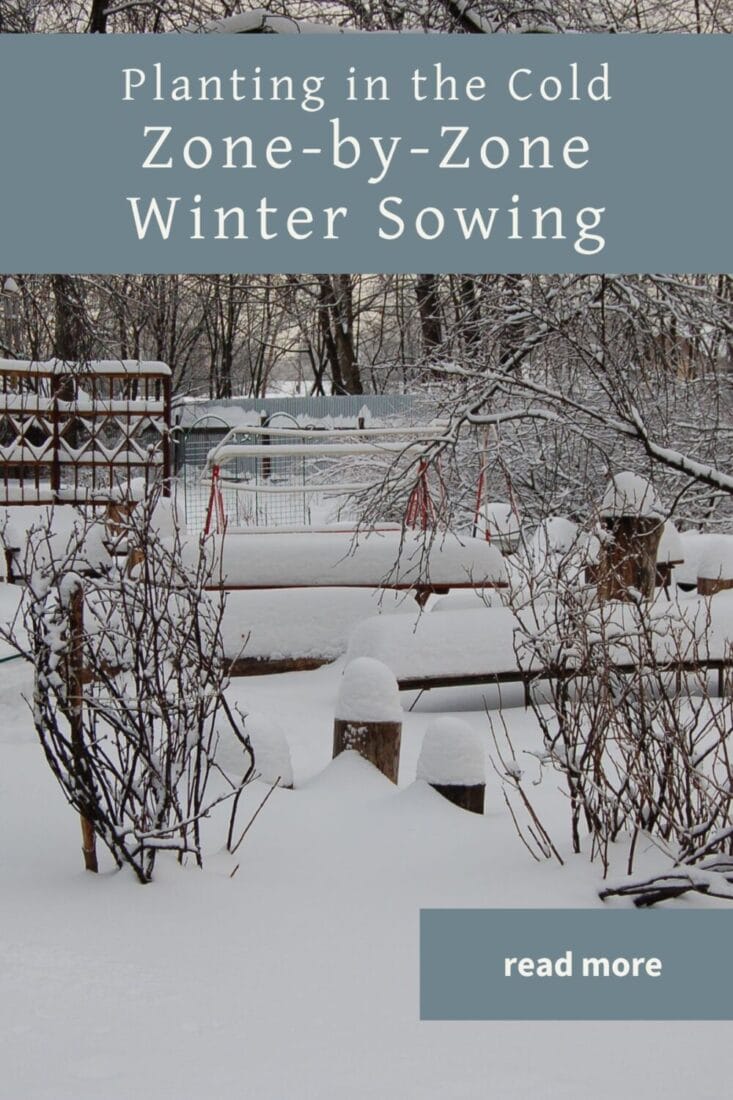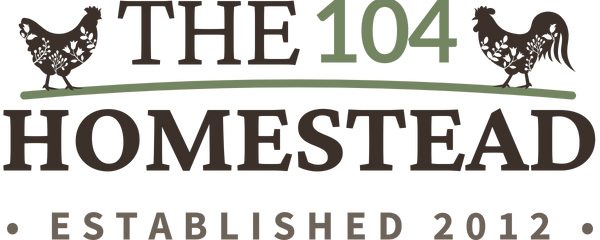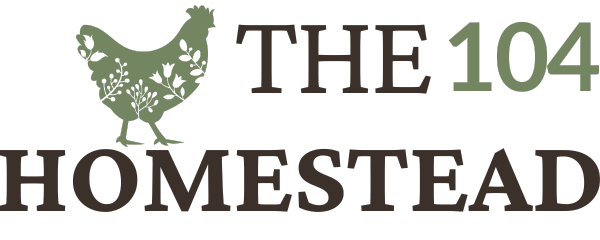Winter Sowing Tips: Seed Starting by Zone + Additional Info
How do I know what to sow and when to sow it? What kind of containers can I use? What about watering? Answers to these questions and more.

You asked for it in our Guide to Winter Sowing post, and I’m here to deliver. I told you all about how I start my seeds in the dead of winter, and you all had a lot of questions for me. How do I know what to sow and when to sow? What kind of containers can I use? What about watering? I’ve got the answers to these questions and more. Discover how to winter sow seeds where you live.
Winter sowing is a gardening technique where seeds are sown in containers during winter, allowing them to stratify and germinate as the weather warms in spring. The seeds are placed in outdoor containers with lids or covers, mimicking a mini greenhouse effect. This method utilizes the natural cycles of winter, encouraging the seeds to break dormancy at the right time. It’s a hands-off approach that taps into the resilience of nature, providing a head start for plants that will thrive when the growing season arrives.
How do I know if my seeds are good candidates for winter sowing?
Look for these key terms on your seed packets.
- Hardy seeds
- Seedlings can withstand frost
- Sow outdoors in late autumn or early winter
- Sow outdoors in early spring when nights are still cool
- Needs pre-chilling
- Requires stratification (cold, moist conditions)
All of these key terms indicate that a seed is a good candidate for winter sowing. Of course, your climate and gardening zone will play an important part in the success of winter sowing.
How deep do I sow my seeds?
The general rule of thumb is to plant twice the depth of the seed’s smallest dimension at the spacing indicated by your seed packet. Honestly, I don’t worry too much about proper spacing or depth with tiny seeds. I sprinkle them in and cover them with a light layer of soil. When they begin germinating and sprouting in the spring, I thin as needed.
What do I use if I don’t have enough milk cartons?
There are a lot of great upcycle container ideas out there. Basically, any container that allows light inside will do. Here is a small list to get you started:
- Soda Bottles
- Bakery Containers
- Clear Storage Totes
- Deli Chicken Containers
- Travel Tin Foil Containers
- Meat & Cheese Platters (for shallow-rooted seedlings)
- Juice Cartons with the tops cut off and a baggie over the top (more suitable for southern locations)
Just be sure if you are using a container that doesn’t have a lid or cap, you drill in a few ventilation/moisture holes along the top.
What if I don’t have snow?
Winter is just a cooler season, not necessarily bitter cold and snow. Winter sowing is merely getting a head start for your growing season, allowing nature to take care of everything. It’s like greenhouse gardening on a small scale.
When is the earliest I can start Winter Sowing?
The Winter Solstice seems to be a good starting point. The days are at their shortest, and typically, the temperatures are at their coldest. The concern with starting too early is that the seeds will begin to sprout while the temperatures are too low to support the plant. By planting in the “dead of winter,” you can be fairly confident that the seeds won’t start until spring is beginning.
What do I do come spring?
You treat your winter-sown seedlings just like you would any other seedling. You’ll want to remove the lid during the daytime to harden them off and transplant them when the soil is warm enough.
What about watering?
Mother Nature does a pretty good job at keeping your winter-sown containers at the right moisture level during the dormant period. By keeping the cover off your container or cutting ventilation holes, rain and snow will enter the top, and excess water will drain through the drainage holes. If you notice your soil is looking dry and crumbly, just dribble water along the edges of the soil. It won’t take much water, and you want to do it slowly so you don’t dislodge the seeds. Be sure to use cold water so you don’t shock your seeds.
Once spring arrives, keep an eye on your sprouting seeds. Again, the containers should create a mini-ecosystem. If you notice your containers seem soggy, try moving them to a sunnier location. If they seem to be drying out frequently, move them to an area that gets sunlight but not direct sunlight. If they need to be watered manually, use water at the same temperature as the outdoor temperature and gently water around the edges.
What to Winter Sow Each Month According to Your Gardening Zone
The following guides are just that, GUIDES. Trial and error is the best way to determine when to grow what is in your zone. Gardening zones and frost dates are important to know because they tell you a lot about your growing zone. Click these links below to find out what zone you’re gardening in.
US Garden Zones | CAN Garden Zones | EUR Garden Zones | Other Zones
Zone 3 Growing Guide
Zone 3 typically experiences extremely cold winters, with temperatures dropping as low as -40°F. With a considerably short frost-free period and harsh winter conditions, Zone 3 gardeners utilize winter sowing to gain an edge in the race against time.
February
February is the best time to start perennial flowers and hardy annuals in Zone 3.
- Bellflower
- Blanket Flower
- Butterfly Weed
- Canterbury Bells
- Coneflower
- Delphinium
- False Indigo
- Helleborus
- Hollyhock
- Hosta
- Lily-of-the-Valley
- Mountain Bluet
- Ox-Eye Daisy
- Pincushion Flower
- Pyrethrum
- Rudbeckia
- Veronica
- Yarrow
March
March is the best time to start most herbs and any plants that require stratification if you’re in Zone 3.
- Basil
- Broccoli
- Brussels Sprouts
- Hops
- Horseradish
- Kale
- Marshmallow
- Monkshood
- Onions
- Peas
- Spinach
- St. John’s Wort
- Swiss Chard
- Tarragon
- Wormwood
April
April is the best time to start frost-tolerant vegetables in Zone 3.
- .Beans
- Beets
- Bok Choy
- Lettuce
May
May is the best time to start tender plants in Zone 3.
- Corn
- Cucumbers
- Eggplant
- Peppers
- Pumpkins
- Sweet Potato Slips
- Tomatoes
Zone 4 Growing Guide
Zone 4 experiences cold winters with temperatures ranging between -30°F to -20°F. With a moderately short growing season and the ever-present risk of late spring frosts, Zone 4 gardeners turn to winter sowing to optimize their planting timelines.
January
January is the best time to start perennial flowers and hardy annuals in Zone 4.
- Asters
- Astilbe
- Balloon Flower
- Bee Balm
- Blazing Star
- Carnation
- Coreopsis
- Daylily
- English Daisy
- Helenium
- Iris
- Lamb’s Ear
- Lupine
- Phlox
- Poppies
- Violas
February
February is the best time to start most herbs and any plants that require stratification in Zone 4.
- Basil
- Bergamot
- Broccoli
- Brussels Sprouts
- Chives
- Chamomile
- Clary
- Comfrey
- Garlic
- Kale
- Mint
- Onions
- Peas
- Peppermint
- Spearmint
- Spinach
- Sweet Woodruff
- Swiss Chard
- Thyme
- Walking Onions
March
March is the best time to start frost-tolerant vegetables in Zone 4.
- Bok Choy
- Beets
- Beans
- Lettuce
April
April is the best time to start tender plants in Zone 4.
- Corn
- Cucumbers
- Eggplant
- Peppers
- Pumpkins
- Sweet Potato Slips
- Tomatoes
Zone 5 Growing Guide
In Zone 5, gardeners experience cold winters, typically falling between -10°F to -20°F. With Zone 5 characterized by a distinct winter chill and the potential for late spring frosts, winter sowing provides a reliable means to kickstart the growing season.
December/January
Late December and early January are the best times to start perennial flowers and hardy annuals in Zone 5.
- Blackberry Lily
- Catmint
- Chinese Lanterns
- Chrysanthemum
- Clematis
- Cupid’s Dart
- Evening Primrose
- Flax
- Heather
- Jack-in-the-Pulpit
- Primrose
- Shasta Daisy
January/February
Later January and early February are the best times to start herbs and plants requiring stratification in Zone 5.
- Agrimony
- Basil
- Broccoli
- Brussels Sprouts
- Garlic
- Kale
- Lavender
- Onions
- Oregano
- Peas
- Sage
- Spinach
- Swiss Chard
- Valerian
February/March
Late February and early March are the best times to start frost-tolerant vegetables in Zone 5.
- Beans
- Beets
- Bok Choy
- Lettuce
March/April
Late March and early April are the best times to start tender plants in Zone 5.
- Corn
- Cucumbers
- Eggplant
- Melons
- Peppers
- Pumpkins
- Sweet Potato Slips
- Tomatoes
Zone 6 Growing Guide
In Zone 6, gardeners typically experience moderate winters, with temperatures ranging from 0°F to -10°F. Where winters can be moderately cold, and springs are often unpredictable, winter sowing emerges as a strategic ally for gardeners in Zone 6 seeking a head start on the growing season.
December
December is the best time to start perennial flowers and hardy annuals in Zone 6.
- Broom Flower
- Fleabane
- Fountain Grass
- Lily-of-the-Nile
- Red Hot Poker
- Sea Pink
- Verbena
January
January is the best time to start most herbs and any plants that require stratification in Zone 6.
- Agrimony
- Basil
- Broccoli
- Brussels Sprouts
- Garlic
- Hyssop
- Kale
- Madder
- Onions
- Sage
- Spinach
- Swiss Chard
February
February is the best time to start frost-tolerant vegetables in Zone 6.
- Beans
- Beets
- Bok Choy
- Lettuce
March
March is the best time to start tender plants in Zone 6.
- Corn
- Cucumbers
- Eggplant
- Melons
- Peppers
- Pumpkins
- Sweet Potato Slips
- Tomatoes
Zone 7 Growing Guide
Typically experiencing mild winters and warm summers, Zone 7 can still winter sow. Where these mild winters and occasional frosts characterize the climate, gardeners can cultivate a diverse range of frost-tolerant vegetables.
December
December is the best time to start perennial flowers, hardy annuals, and plants that require stratification in Zone 7.
- Blue Beard
- Broccoli
- Brussels Sprouts
- Garlic
- Kale
- Leadwort
- Onions
- Pampas Grass
- Persian Buttercup
- Peruvian Lily
- Spinach
- Swiss Chard
January
January is the best time to start most herbs and frost-tolerant vegetables in Zone 7.
- Arnica
- Basil
- Beets
- Bok Choy
- Collard Greens
- Lettuce
- Turnips
February
February is the best time to start tender plants in Zone 7.
- Corn
- Cucumbers
- Eggplant
- Melons
- Peppers
- Pumpkins
- Sweet Potato Slips
- Tomatoes
If you’ve found value in this blog post and enjoyed reading it, why not share it with your Pinterest community? Pin the image below and spread the love!

Whether you’re navigating the frigid landscapes of Zone 3 or basking in the milder embrace of Zone 7, the tailored guides pave the way for a flourishing garden. So, let the seeds of curiosity sprout, and may your winter-sown garden be a testament to the wonders of nature and the gardener’s touch.
What’s your go-to winter sowing tip or favorite plant to kickstart in the cold season? Share your gardening wisdom or ask any lingering questions in the comments below!

